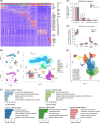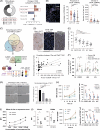Distinct immune microenvironment of venous tumor thrombus in hepatocellular carcinoma at single-cell resolution
- PMID: 40833994
- PMCID: PMC12356573
- DOI: 10.1097/HEP.0000000000001182
Distinct immune microenvironment of venous tumor thrombus in hepatocellular carcinoma at single-cell resolution
Abstract
Background and aims: Portal vein tumor thrombus (PVTT) worsens the prognosis of hepatocellular carcinoma by increasing intrahepatic dissemination and inducing portal vein hypertension. However, the immune characteristics of PVTT remain unclear. Therefore, this study aims to explore the immune microenvironment in PVTT.
Approach and results: Time-of-flight mass cytometry revealed that macrophages and monocytes were the dominant immune cell type in PVTT, with a higher proportion than in primary tumor and blood (54.1% vs. 26.3% and 9.1%, p<0.05). The differentially enriched clustering of inhibitory and regulatory immune cells in PVTT indicated an immune-suppressive environment. According to the single-cell RNA sequencing, TAM-C5AR1 was characterized by leukocyte chemotaxis and was the most common subpopulation in PVTT (36.7%). Multiplex fluorescent immunohistochemistry staining showed that the C5aR+ TAM/Mφ were enriched in PVTT compared to both the primary tumor and liver and positively correlated with C5a (r=0.559, p<0.001). Notably, THP-1 (monocyte cell line) was recruited by CSQT2 (PVTT cell line) and exhibited up-regulation of CD163, CD206, and PD-L1 upon stimulation. C5aR antagonist could reverse this. C5aR+ TAMs could also inhibit Granzyme B in CD8+ T cells. High infiltration of C5aR+ TAMs in PVTT correlated with poor differentiation (p<0.009) and was a risk factor for overall survival (p=0.003) and for reformation of PVTT after resection (p=0.007).
Conclusions: TAMs, especially C5aR+ TAMs, were enriched in PVTT. C5aR+ TAMs contribute to the development of PVTT and poor prognosis by reshaping the immunosuppressive environment.
Keywords: hepatocellular carcinoma; immune microenvironment; portal vein tumor thrombus/thrombosis; single-cell omics.
Copyright © 2024 The Author(s). Published by Wolters Kluwer Health, Inc.
Conflict of interest statement
The authors have no conflicts to report.
Figures







References
-
- Villanueva A. Hepatocellular carcinoma. N Engl J Med. 2019;380:1450–1462. - PubMed
-
- Bray F, Ferlay J, Soerjomataram I, Siegel RL, Torre LA, Jemal A. Global cancer statistics 2018: GLOBOCAN estimates of incidence and mortality worldwide for 36 cancers in 185 countries. CA Cancer J Clin. 2018;68:394–424. - PubMed
-
- Liu PH, Huo TI, Miksad R. Hepatocellular carcinoma with portal vein tumor involvement: Best management strategies. Semin Liver Dis. 2018;38:242–251. - PubMed
-
- Mähringer-Kunz A, Steinle V, Düber C, Weinmann A, Koch S, Schmidtmann I, et al. Extent of portal vein tumour thrombosis in patients with hepatocellular carcinoma: The more, the worse? Liver Int. 2019;39:324–331. - PubMed
MeSH terms
LinkOut - more resources
Full Text Sources
Medical
Research Materials

